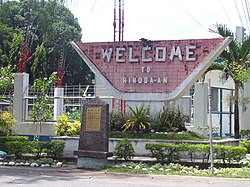Hinoba-an
Hinoba-an | |
|---|---|
 | |
 Peta Negros Barat dengan Hinoba-an dipaparkan | |
 | |
| Koordinat: 9°36′06″N 122°28′01″E / 9.601789°N 122.466833°EKoordinat: 9°36′06″N 122°28′01″E / 9.601789°N 122.466833°E | |
| Negara | Filipina |
| Daerah | Visayas Barat (Daerah VI) |
| Wilayah | Negros Barat |
| Barangay | 13 |
| Tarikh asas | 20 November 1948 |
| Pentadbiran | |
| • Pengundi | 38,279 (9 Mei 2022) |
| Keluasan | |
| • Jumlah | 414.50 km2 (160.04 batu persegi) |
| Aras | 78 m (256 ft) |
| Penduduk (1 Mei 2020) [2] | |
| • Jumlah | 60,865 |
| • Kepadatan | 150/km2 (380/batu persegi) |
| • Bilangan rumah | 14,099 |
| Ekonomi | |
| • Kelas pendapatan | pendapatan kelas pertama perbandaran |
| • Kadar kemiskinan | 24.63% (2018)[3] |
| • Hasil | ₱252,369,701.68 (2020) |
| • Aset | ₱434,568,765.66 (2020) |
| • Liabiliti | ₱155,694,366.73 (2020) |
| • Perbelanjaan | ₱247,268,150.05 (2020) |
| Zon waktu | UTC+8 |
| Poskod | 6114 |
| PSGC | 064512000 |
| Kod kawasan | +63 (0)34 |
| Jenis iklim | iklim tropika |
| Bahasa peribumi | bahasa Hiligai bahasa Tagalog bahasa Sugbu |
| Laman sesawang | www |
Hinoba-an atau lebih dikenali sebagai Perbandaran Hinoba-an merupakan sebuah perbandaran di wilayah Negros Barat, Filipina. Perbandaran ini mempunyai jumlah penduduk seramai 60,865 dalam isi rumah 14,099. Ia mempunyai luas 414.50 kilometer persegi dan ketinggian 78 meter di atas permukaan laut. Ia diberikan dengan kod kawasan telefon +63 (0)34 dan poskod 6114.
Barangay[sunting | sunting sumber]
- Alim
- Asia
- Bacuyangan
- Barangay I (Pob.)
- Barangay II (Pob.)
- Bulwangan
- Culipapa
- Damutan
- Daug
- Po-ok
- San Rafael
- Sangke
- Talacagay
Demografi[sunting | sunting sumber]
| Tahun | Pend. | ±% setiap tahun |
|---|---|---|
| 1960 | 8,630 | — |
| 1970 | 17,475 | +7.30% |
| 1975 | 32,357 | +13.15% |
| 1980 | 45,819 | +7.20% |
| 1990 | 40,813 | −1.15% |
| 1995 | 40,819 | +0.00% |
| 2000 | 50,809 | +4.81% |
| 2007 | 53,894 | +0.82% |
| 2010 | 54,624 | +0.49% |
| 2015 | 56,819 | +0.75% |
| 2020 | 60,865 | +1.36% |
| Ref: Lembaga Perangkaan Filipina [4] [5] [6] | ||
Ekonomi[sunting | sunting sumber]
| Kadar kemiskinan | |
| Ref: Lembaga Perangkaan Filipina[7][8][9][10][11][12][13][14] | |
Rujukan[sunting | sunting sumber]
- ^ "Province:". PSGC Interactive. Bandar Quezon, Filipina: Lembaga Perangkaan Filipina. Dicapai pada 12 November 2016.
- ^ Census of Population (2020). "Region VI (Western Visayas)". Total Population by Province, City, Municipality and Barangay. PSA. Dicapai pada 8 Julai 2021.
- ^ "PSA Releases the 2018 Municipal and City Level Poverty Estimates". 15 Disember 2021. Dicapai pada 22 Januari 2022.
- ^ Census of Population (2015). "Region VI (Western Visayas)". Total Population by Province, City, Municipality and Barangay. PSA. Dicapai pada 20 Jun 2016.
- ^ Census of Population and Housing (2010). "Region VI (Western Visayas)". Total Population by Province, City, Municipality and Barangay. NSO. Dicapai pada 29 Jun 2016.
- ^ Censuses of Population (1903–2007). "Region VI (Western Visayas)". Table 1. Population Enumerated in Various Censuses by Province/Highly Urbanized City: 1903 to 2007. NSO.
- ^ "Kadar kemiskinan:". Lembaga Perangkaan Filipina. Dicapai pada 28 Disember 2020.
- ^ "Estimation of Local Poverty in the Philippines" (PDF). 29 November 2005.
- ^ "2003 City and Municipal Level Poverty Estimates" (PDF). 23 Mac 2009.
- ^ "City and Municipal Level Poverty Estimates; 2006 and 2009" (PDF). 3 Ogos 2012.
- ^ "City and Municipal Level Poverty Estimates; 2006 and 2009" (PDF). 3 Ogos 2012.
- ^ "2012 Municipal and City Level Poverty Estimates" (PDF). 31 Mei 2016.
- ^ "Municipal and City Level Small Area Poverty Estimates; 2009, 2012 and 2015". 10 Julai 2019.
- ^ "PSA Releases the 2018 Municipal and City Level Poverty Estimates". 15 Disember 2021. Dicapai pada 22 Januari 2022.
Pautan luar[sunting | sunting sumber]
- PhilAtlas.com
- Philippine Standard Geographic Code
- Philippine Census Information
- Local Governance Performance Management System
- www
.hinobaan .gov .ph

